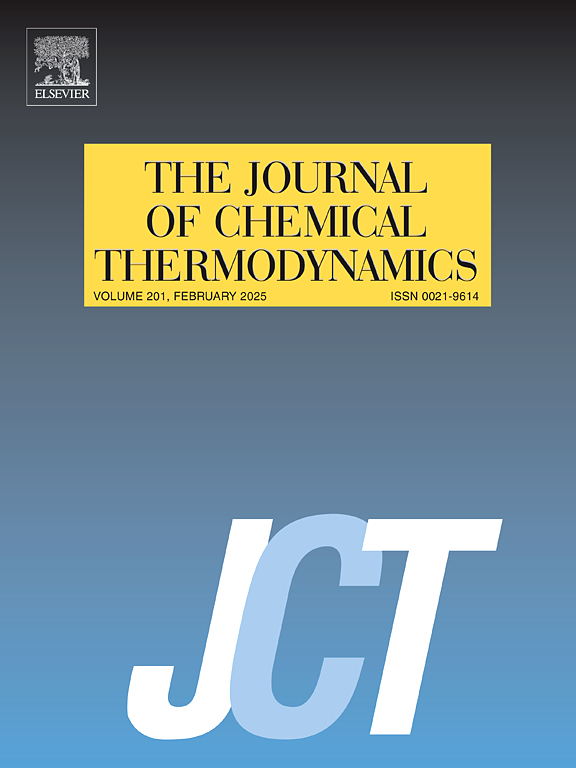利用 PFP 和 ERAS 模型研究二乙二醇单乙醚与 2-烷醇(C3 - C7)的热力学性质
IF 2.2
3区 工程技术
Q3 CHEMISTRY, PHYSICAL
引用次数: 0
摘要
根据实验密度 ρ、声速 u 和折射率 nD,通过安东帕 / DSA 5000/ 密度计和安东帕 Abbemat / 500/ 折射仪计算了过剩体积 VmE、过剩分体积 V¯m,iE、等熵压缩性偏差 Δ Ks 和折射率偏差 ΔnD等热力学性质。研究了二乙二醇单乙醚(DEGEE)+2-丙醇,或+2-丁醇,或+2-戊醇,或+2-己醇,或+2-庚醇的体系,其温度为 T = (298.15-318.15) 10 K 间隔,环境压力为 (81.5 kPa)。数据由 Redlich-Kister 关系拟合。所观察到的 VmE 对 + 2-丙醇为负值,对其他体系为正值。除 + 2-庚醇体系的 Δ Ks 为正值外,其他体系的 Δ Ks 均为负值。ΔnD 在 + 2- 己醇或 + 2- 庚醇体系中为负值,其余体系均为正值。讨论了二元混合物的分子间相互作用和结构因子。此外,还使用了 Prigogine-Flory-Patterson 理论(PFP)和扩展实关联解(ERAS)模型来关联二元混合物的 VmE 数据。所有系统的拟合数据与所有系统的实验数据一致。本文章由计算机程序翻译,如有差异,请以英文原文为准。
The study of thermodynamic properties of diethylene glycol monoethyl ether with 2-alkanols (C3 − C7) with use of PFP and ERAS modeling
Thermodynamic properties like excess volume , excess partial volume in isentropic compressibility deviations Δ , and refractive index deviations have been calculated based on experimental density ρ, speed of sound u, and refractive index by an Anton Paar / DSA 5000/ densimeter and Anton Paar Abbemat / 500/ refractometer. The systems of diethylene glycol monoethyl ether (DEGEE) + 2-propanol, or + 2-butanol, or + 2-pentanol, or + 2-hexanol, or + 2-heptanol, were given at T = (298.15–318.15) in 10 K intervals at ambient pressure (81.5 kPa) have been investigated. Data was fitted by Redlich-Kister relation. is negative for + 2-propanol and positive sign for other systems observed. The Δ is negative for all systems, except for + 2-heptanol system is positive. The is negative for + 2-hexanol or + 2-heptanol systems and is positive for all the rest. The The intermolecular interactions and structure factors were discussed for the binary mixtures. In addition the Prigogine–Flory–Patterson theory (PFP) and Extended Real Associated Solutions (ERAS) models were used to correlate data of binary mixtures. The fitting data for all systems reasonable consistency with experimental data for all the systems.
求助全文
通过发布文献求助,成功后即可免费获取论文全文。
去求助
来源期刊

Journal of Chemical Thermodynamics
工程技术-热力学
CiteScore
5.60
自引率
15.40%
发文量
199
审稿时长
79 days
期刊介绍:
The Journal of Chemical Thermodynamics exists primarily for dissemination of significant new knowledge in experimental equilibrium thermodynamics and transport properties of chemical systems. The defining attributes of The Journal are the quality and relevance of the papers published.
The Journal publishes work relating to gases, liquids, solids, polymers, mixtures, solutions and interfaces. Studies on systems with variability, such as biological or bio-based materials, gas hydrates, among others, will also be considered provided these are well characterized and reproducible where possible. Experimental methods should be described in sufficient detail to allow critical assessment of the accuracy claimed.
Authors are encouraged to provide physical or chemical interpretations of the results. Articles can contain modelling sections providing representations of data or molecular insights into the properties or transformations studied. Theoretical papers on chemical thermodynamics using molecular theory or modelling are also considered.
The Journal welcomes review articles in the field of chemical thermodynamics but prospective authors should first consult one of the Editors concerning the suitability of the proposed review.
Contributions of a routine nature or reporting on uncharacterised materials are not accepted.
 求助内容:
求助内容: 应助结果提醒方式:
应助结果提醒方式:


